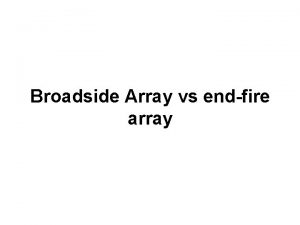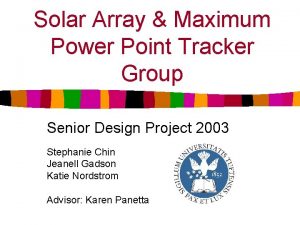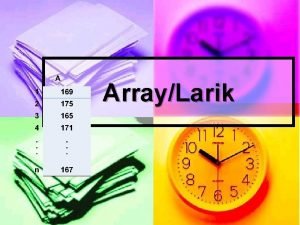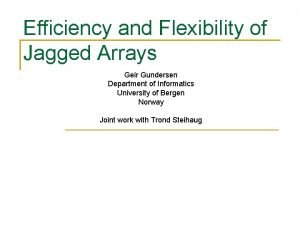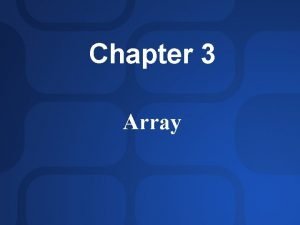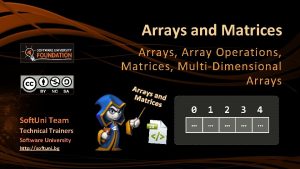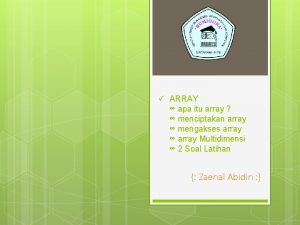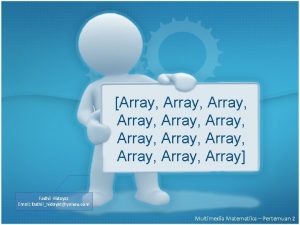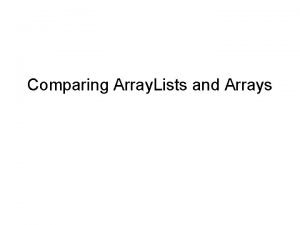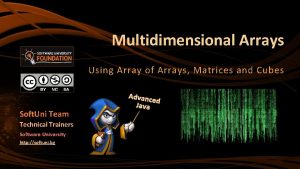Ch 5 Arrays Matrices ARRAYS MATRICES An array







- Slides: 7

Ch. 5 Arrays & Matrices

ARRAYS & MATRICES • An array can be considered as a multiply subscripted collection of data entries, for example numeric. • A dimension vector is a vector of non-negative integers. If its length is k then the array is k-dimensional, e. g. a matrix is a 2 -dimensional array. • The assignment > dim(z) <- c(3, 5, 100) gives it the dim attribute that allows it to be treated as a 3 by 5 by 100 array • ARRAY INDEXING , SUBSECTIONS OF AN ARRAY • Individual elements of an array may be referenced by giving the name of the array followed by the subscripts in square brackets, separated by commas. • subsections of an array may be specified by giving a sequence of index vectors in place of subscripts; however if any index position is given an empty index vector, then the full range of that subscript is taken.

• If the dimension vector for an array, say a, is c(3, 4, 2) then there are 3 * 4 *2= 24 entries in a and the data vector holds them in the order a[1, 1, 1], a[2, 1, 1], . . . , a[2, 4, 2], a[3, 4, 2]. The dimension vector may be referenced explicitly as dim(Z) (on either side of an assignment). INDEX MATRICES • Negative indices are not allowed in index matrices. NA and zero values are allowed: rows in the index matrix containing a zero are ignored, and rows containing an NA produce an NA in the result. ARRAY FUNCTION() • Arrays may be used in arithmetic expressions and the result is an array formed by element by- element operations on the data vector. The dim attributes of operands generally need to be the same, and this becomes the dimension vector of the result.

VECTOR & ARRAY ARITHMETIC • The expression is scanned from left to right. • Any short vector operands are extended by recycling their values until they match the size of any other operands. • As long as short vectors and arrays only are encountered, the arrays must all have the same dim attribute or an error results. • Any vector operand longer than a matrix or array operand generates an error. • If array structures are present and no error or coercion to vector has been precipitated, the result is an array structure with the common dim attribute of its array operands. • OUTER PRODUCT OF TWO ARRAYS • If a and b are two numeric arrays, their outer product is an array whose dimension vector is obtained by concatenating their two dimension vectors (order is important), and whose data vector is got by forming all possible products of elements of the data vector of a with those of b. • The outer product is formed by the special operator %o%: > ab <- a %o% b

TRANSPOSE OF AN ARRAY, MATRIX FACILITIES • Generalized transpose of an array • The function aperm(a, perm) may be used to permute an array, a. The argument perm must be a permutation of the integers f 1; : : : ; kg, where k is the number of subscripts in a. The result of the function is an array of the same size as a but with old dimension given by perm[j] becoming the new j-th dimension. • MATRIX FACILITIES • A matrix is just an array with two subscripts. • R contains many operators and functions that are available only for matrices. For example t(X) is the matrix transpose function. • The operator %*% is used for matrix multiplication • If, for example, A and B are square matrices of the same size, then • >A*B is the matrix of element by element products and > A %*% B is the matrix product.

q If x is a vector, then > x %*% A %*% x is a quadratic form. • The function crossprod() forms “crossproducts”, meaning that crossprod(X, y) is the same as t(X) %*% y but the operation is more efficient. • The meaning of diag() depends on its argument. diag(v), where v is a vector, gives a diagonal matrix with elements of the vector as the diagonal entries. On the other hand diag(M), where M is a matrix, gives the vector of main diagonal entries of M. EIGEN VALUES & EIGEN VECTORS q The function eigen(Sm) calculates the eigenvalues and eigenvectors of a symmetric matrix Sm. The result of this function is a list of two components named values and vectors. The assignment Øev <- eigen(Sm) will assign this list to ev. Øev$val is the vector of eigenvalues of Sm and ev$vec is the matrix of corresponding eigenvectors. > evals <- eigen(Sm)$values SINGULAR VALUE DECOMPOSITION & DETERMINANTS q The function svd(M) takes an arbitrary matrix argument, M, and calculates the singular value decomposition of M If M is A square, then, it is not hard to see that > absdet. M <- prod(svd(M)$d) calculates the absolute value of the determinant of M.

LEAST SQUARES FITTING AND THE QR DECOMPOSITION q. The function lsfit() returns a list giving results of a least squares fitting procedure. An assignment such as > ans <- lsfit(X, y) gives the results of a least squares fit where y is the vector of observations and X is the design matrix. FORMING PARTITIONED MATRICES, cbind() and rbind() q. In the assignment > X <- cbind(arg_1, arg_2, arg_3, . . . ) the arguments to cbind() must be either vectors of any length, or matrices with the same column size, that is the same number of rows. The result is a matrix with the concatenated arguments arg 1, arg 2, . . . forming the columns q. The function rbind() does the corresponding operation for rows. THE CONCATENATION FUNCTION, c(), WITH ARRAYS q. It should be noted that whereas cbind() and rbind() are concatenation functions that respect dim attributes, the basic c() function does not, but rather clears numeric objects of all dim and dimnames attributes. FREQUENCY TABLES FROM FACTORS q. A pair of factors defines a two way cross classification. If there are k factor arguments, the result is a k-way array of frequencies.

